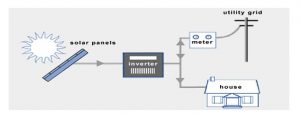Solar Power, It’s Your, It’s Free!

SMS Envocare
June 6, 2017Sunlight: not only can it make us feel calm and happy on a beautiful sunny day, but it can also be put to work to greatly reduce our electricity bills.
Just as sunlight can be considered in two forms – heat and light – solar energy can also be divided into two main components – Solar Light Energy known as Solar Photovoltaic (PV) and Solar Heat Energy kown as Solar Thermal.
Why go Solar?
When you install a solar energy system on your property, you save money on your electricity bills and protect yourself against rising electricity rates in the future.
Going solar also reduces greenhouse gas emissions, which contribute to climate change, and also results in fewer air pollutants like sulfur dioxide and particulate matter, which can cause health problems.
How do Solar panels work?
Solar panels work on the concept of Photo-voltaic effect, where the photons (sunlight) excite the electrons in the solar panel that results in flow of electricity which then is converted from direct current (DC) to Alternating current (AC) by an inverter. At that point, you either use the electricity in your house/ office/ indutry or send it back to the electric grid.
Solar panels work best when they are installed pointing directly at the sun, and in a position where nothing is blocking them (such as trees).

What are the various modes under which we can setup a Solar Power plant?
The various modes under which a Solar Power plant can be setup depends on the specific requirement. All the following are valid modes and the costs for each kind of system varies based on various factors:
• Off-Grid Captive Consumption for domestic premises
• Off-Grid Captive Consumption for commercial premises
• Grid Connected (Net Metered) Captive Consumption for domestic premises
• Grid Connected (Net Metered) Captive Consumption for commercial premises
• Sale of Power generated to local Distribution Company (DISCOM)
• Sale of Power generated to 3rd Party consumer (Industry or Commercial entity)
What is Net Metering arrangement and what are its benefits?
Net metering is the system that utilities use to credit solar energy system owners for the electricity produced by their solar panels. With net metering, you only pay for the electricity that you use beyond what your solar panels can generate. For net metering, a bilateral meter is installed that records the solar power you have produced and fed back to the grid as well as the power you have used from the utility.
Net metering has reduced the requirement of expensive batteries, unless you want a small battery backup system for power outages. For more details, click here.
What is the average cost of grid connected rooftop solar systems?
The average cost of a 100 KW grid connected rooftop solar systems (without battery) is about Rs. 60 Lacs (i.e. Rs. 60 per watt).
The payback period of a solar PV generation units may range from 3 to 10 years depending primarily on the energy tariffs prevailing at the residential/ industrial/ institutional or commercial facility.
How much land is required to set up a solar PV power generation unit?
Solar PV units can either be set up on rooftops of any residential, commercial, institutional and industrial buildings or can be ground mounted. Considering the present commercial efficiencies in solar panels, a typical 1 kW rooftop system in India would require an 8-10 sq. metres of flat, shadow-free area (preferably south-facing). The area requirement decreases as the efficiencies improve. Actual sizing, however, depends also on local factors of solar radiation and weather conditions and shape of the roof.
What is the life-time of a typical Solar Power plant?
The useful life of a typical Solar Power plant is considered to be 25 years. However, Solar Power plants can run beyond 25 years while producing a lower output. Most of the Solar Panel manufacturers guarantee an output of 90% at the end of 10 years and 80% at the end of 25 years.
What is the annual energy generated from a 100 KW Solar Power plant?
A typical 100 KW Solar Power plant at Nagpur would generate 1.5 lakh units (i.e. 150000 KWh). However, the amount of actual energy generated from a Solar Power Plant for a given location in a year depends on both internal and external factors. External factors which are beyond the control of a Solar developer can include the following:
• Number of sunny days
• Solar Irradiation
• Day Temperatures
The output also depends on the following internal factors all of which are within the control of a Solar Developer:
• Plant Location
• Usage of Solar Tracking systems
• Quality of equipment used
• Workmanship of the EPC contractor
• O&M activities

